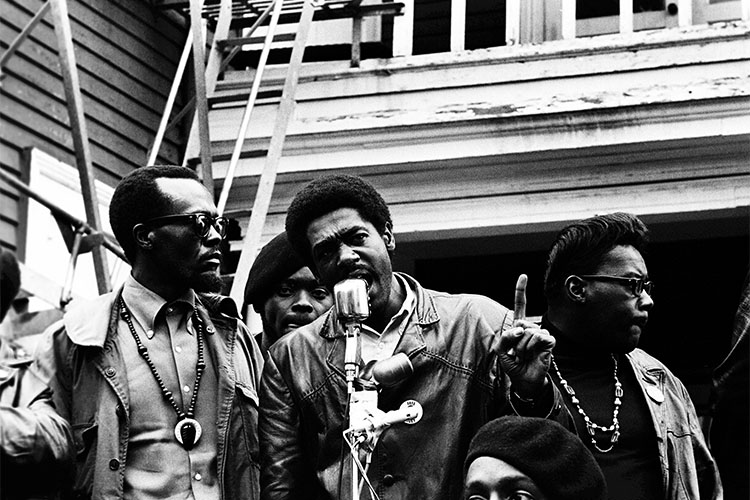Black Power, Black Panthers focus of North Gate photo exhibit
The Graduate School of Journalism is hosting "Power to the People," a photographic tribute to the Black Panther Party and black power movement founded in the Bay Area 50 years ago.

September 28, 2016

Members of the Black Panthers lined up at a Free Huey (Newton) rally in DeFremery Park in Oakland. (Photo by Stephen Shames/Polaris)
Berkeley — Five decades after the founding of the Black Panther Party, an exhibit of two dozen photos taken from the front lines of the history-making, activist organization rooted in the San Francisco Bay Area opens Wednesday, Oct. 19, at the University of California, Berkeley’s Graduate School of Journalism.
The “Power to the People: The World of the Black Panthers” exhibit in the Reva and David Logan Gallery of Documentary Photography at North Gate Hall stirs memories of the Black Power movement for those who remember it, and instruction for those who don’t.
It also offers a bracing backdrop to current national dialogue and tensions around race as seen in reactions to the Black Lives Matter movement, protests following fatal police shootings of black men and boys, San Francisco 49ers’ quarterback Colin Kaepernick’s refusal to stand for the National Anthem, and more.
Ken Light, the journalism school’s Reva and David Logan Professor of Photojournalism, said the photos by Stephen Shames “bring history alive and show the power of photography to record and share the Black Panthers’ social consciousness with generations that have only heard about them. Millennials and Gen Xers who are marching in the streets and raising their voices can share in the power, the pride and the struggle that was started over 50 years ago and come away with a renewed sense that Black Lives Matter.”
Shames’s exhibit of 24 black-and-white gelatin prints shows the Black Panther Party as “one of the most creative and influential responses to racism and inequality in American history,” said Light. “And it reveals that each generation of the black community continues to fight for its voice and identity.”
The exhibit is a sampling of work by Shames, a photographer who first connected with Panther co-founder Bobby Seale and the Panthers at a 1967 anti-Vietnam War rally in San Francisco, while Shames was working to earn his B.A. degree in history at UC Berkeley.
Shames received unparalleled access to photograph Panther activities as the organization rallied for racial justice and civil rights, protested policy brutality, provided free breakfasts to children in poor neighborhoods, led armed patrols of Oakland neighborhoods and proved an irresistible target for the J. Edgar Hoover-led FBI.
Shames and Seale will sign copies of the “Power to the People” book containing Shames’ photos, with text by Seale, from 6-7 p.m. on Oct. 19. Then the two will sit down for a public conversation about their work from 7-8:30 p.m. at nearby Sibley Auditorium.
Altogether, Shames is the author of eight photo books, including The Black Panthers (2006). He has received the Kodak Crystal Eagle Award for Impact in Photojournalism, and awards from Leica, International Center of Photography, Robert F. Kennedy Journalism Awards, World Press and the New York Art Director’s Club.
A map, directions and parking information are online.
In February, USA Today published a report on the five things people should know about the Black Panther Party.